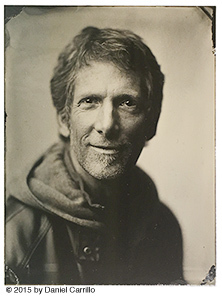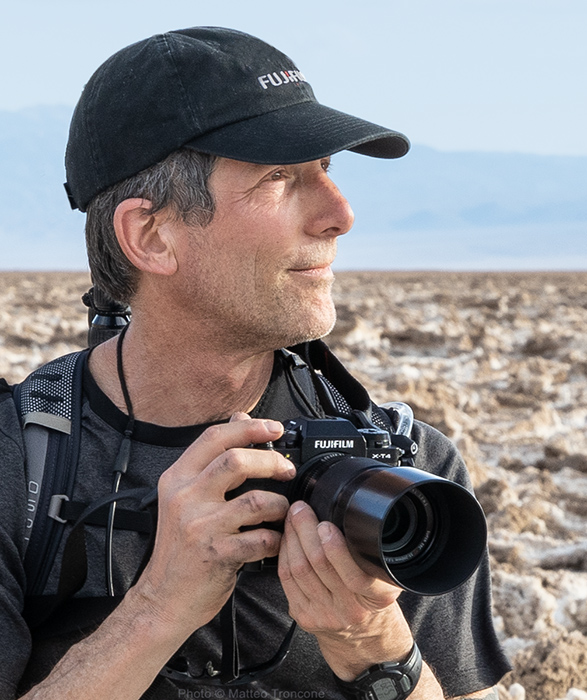I recently received a little gift— a chance to slow down, reflect on my favorite creative Photoshop techniques and recall how my current artistic style is influenced by grade-school experiments.
This collaboration began with an email from artist/author/instructor Seán Duggan. We had met a few summers ago while both teaching Photography and Photoshop at Maine Media Workshops, and revealed that we enjoyed each others’ work. In his email, Seán asked if I would like to contribute to “Photoshop Masking and Compositing”, a new Photoshop book he was co-writing with digital artists Katrin Eismann and James Porto.
I knew it would be a pleasure to contribute to a book by any or all of these authors, and that no matter how busy, I would make time for this.
The ‘catch’ was that Seán needed all materials in a few days, and I had just landed in Aspen to teach a solid week of photography to a very full class. Seán was teaching too, but in Iceland, and under a rapidly nearing deadline.
He sent me a brief outline of ideas for illustrated spreads about creative Photoshop artists’ processes called: “Artist In the First Person”. To illustrate my contribution, I would need to access and reformat some high-res images, but I had only my ‘lean, clean teaching machine’ MacBookPro with me. Fortunately, I had cloned my studio MacPro tower’s work files onto a 1.5tb portable Seagate Go-Flex Free-Agent drive, so I had my whole high-res portfolio with me. Score!
After a few email volleys over international datelines, we chose three of my more personal artworks and the context of my written contribution. I assumed that most contributors would talk about their present creative process, but I wanted to inform readers about how I began—at age seven— and got to where I am. It was fun to recall my metamorphosis and also talk about how I approach my artwork today. My thinking was that many emerging Photoshop artists might enjoy knowing that using PS is a process of practice, creative play, doing and lots of undoing. It is possible to truly express yourself through Photoshop once you know the tools and have spent the time to immerse into the brilliance and complexity of the application. It is also in making little accidents that you really learn Photoshop, and yourself.
My personal take-away from this experience was that collaborating with others, even in a small way, is a truly rewarding experience of giving back. Sharing what we know is what we are here to do.
Some people keep a journal, and through that practice they are deeply in touch with what matters to them. I don’t often write, but I do use photographic explorations as my chronological mirror. One way to do this is the revealing self portrait, and I’ll soon write more about this process in an upcoming post.
~
Here is an expanded version of my feature in “Photoshop Masking and Compositing”:
“I’ve been using Photoshop since 1993, but I had prayed for it 30 years earlier. Not satisfied with the crayons given to me in grade school, I pasted scrap images cut from magazines onto cardboard collected from my dad’s dry-cleaned shirts. Eventually, I began collaging and drawing entire scenes where machines with human limbs and household appliance heads spoke in math symbols from airborne automobiles. When my artwork triggered alarming concern from my parents and teachers, I knew I was onto something and I was soon hooked on collage.
In my teens and with a borrowed camera, I shot parts of what I had seen in my dreams and became fascinated with surrealism. I was especially drawn to the photographic magic of Man Ray, Jiri Kolar, Jerry Uelsmann, and the graphic wizardry of record album covers. While working part time at Harvard (pron: Haahvad) as a lab assistant in a subterranean warren of sealed rooms, I explored my first photographic darkroom. Though many have found mecca in such glowing red creative havens, I became frustrated and felt confined to in yet another corrosive bat cave. I longed for a precise montage process with instant visual feedback and editing. i would have to wait, so I learned to create montaged illustrations and assemblages in mixed media. Twenty years later, while on staff as a visual designer at TimeWarner/HBO, I discovered Photoshop 2.5 and dove into the deep end with eyes wide open. Photoshop was still lean and slow, but when version 3.0 was released, it held the tools I craved: layers, instant revisions, unlimited color options, textures, opacity, and precision masking. Flash forward to present; It is through a combination of layers, masks, and selective filtration that I can now create almost anything I conceive.
Sitting down at the computer to find a concept and make art doesn’t necessarily start my ideas flowing. My brain-train likes to be moving, so I discover some of my best ideas while exercizing, kayaking, hiking or dancing. I also sketch in a Moleskine book while attending performances or when evesdropping on adjacent conversations. I refine the best of my simple scrawls and import them as a template into Photoshop. To bridge my mind to the software, I use my beloved Wacom Intuos pen tablet and a Cintiq pen tablet display to keep the tactile quality of pen in hand, and to give me pressure sensitive control in the digital world. To regain the tactile feel of a pencil when sketching in Photoshop, I sometimes tape a sheet of paper directly onto my tablet.
Today, I use digital cameras, scanners, and Photoshop to complete assignments for clients and my own personal image explorations. My process varies depending on the nature of my input or my goal. I sometimes have a pre-visualized idea to accomplish through purposeful and somewhat linear production steps. For that process, I sketch my idea and then build it with plenty of room for interpretation. At least as often, I truly wing it. If am inspired by something—an image, a film, place, a conversation or event—my ADD brain leads my thoughts down a winding path of ideas and tireless experimentation. That’s when I really burn the midnight oil and take my most adventurous visual journeys.
“I become lost, and found, in Photoshop.”
When I work with clients, they may come to me with a rough concept or at least a title to target with my visual. I then I brainstorm my ideas into rough sketches for discussion or approval. Collaborating with them energizes me more than confines me, and with my problem solving experience as an art director, I am usually given a creatively free hand. I like my work to have a powerful ‘first read’, but reveal deeper ideas to reward the curious viewer within my crafted and often peculiar details. I like to spark the imagination yet leave some interpretation to the viewer.
Symbolism plays an important role in my work and clues in the viewer to what I am revealing about the subject, and about myself. For example, butterflies are used to suggest an ephemeral yet powerful icon of transformation, beauty, fragility and my years of collecting in both urban and tropical forests. Hearts, keys, eyes, clocks, gears, and numbers hang from wires, and objects are served up by floating hands. I also brand my former passions in entomology by embedding a tiny Ant element in nearly every composite.”
“For me, Photoshop is powerful, wondrous, precise, and limitless. Photoshop helps me express myself.”
If you’d like to create your own photo-illustrations and enhance photographs with originality and expertise, I invite you to join me in one of my upcoming Creative Photoshop workshops, or schedule personal live tutorial sessions using free Skype desktop sharing. I’ve got lots to share with you.
~ dj
Quoted (edited) text excerpt from “Photoshop Masking & Compositing” by Katrin Eismann, Seán Duggan, and James Porto. Copyright © 2013. Used with permission of Pearson Education, Inc. and New Riders.
Just fill in the blanks to subscribe for more travel stories and techniques in Photography, Lightroom and Photoshop.
I occasionally send out "The Viewfinder" e-newsletter, and provide free presets and workshop discounts.
I never over-post, share your info, and you can opt out at any time.








Congratulations! Love Katrin’s books..have 2…my photoshop bibles!
xcellent
Sean is a cool guy, I met him at the Workshops too.